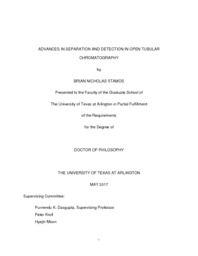
ATTENTION: The works hosted here are being migrated to a new repository that will consolidate resources, improve discoverability, and better show UTA's research impact on the global community. We will update authors as the migration progresses. Please see MavMatrix for more information.
Show simple item record
| dc.contributor.advisor | Dasgupta, Purnendu K | |
| dc.creator | Stamos, Brian Nicholas | |
| dc.date.accessioned | 2023-09-11T13:50:25Z | |
| dc.date.available | 2023-09-11T13:50:25Z | |
| dc.date.created | 2017-05 | |
| dc.date.submitted | May 2017 | |
| dc.identifier.uri | http://hdl.handle.net/10106/31651 | |
| dc.description.abstract | Ion chromatography is an important method of analysis in the field of analytical chemistry with applications in a wide variety of applications from pharmaceutical analysis to purity assurance in semiconductor raw materials. The initial motivator for this research, however, was an extraterrestrial one; to perform ionic analysis of Martian soil extracts.
The research reported in this dissertation had two major goals. The primary goal was to create a method of conductivity detection that was applicable to small inner diameter open tubular capillaries. An auxiliary goal was to apply this method of detection in ways that were previously not possible. I, did, however, take part in other research, that were not related to these central themes. These are included as appendices.
To accomplish the primary goal, a detection method, commonly referred to as Capacitively Coupled Contactless Conductivity Detection (C4D) was adopted and improved. Previous technology allowed measurement of ions in the low-mid mM range in capillary bores down to 20 µm. Smaller capillaries are advantageous for open tubular chromatographic separations. They permit greater efficiencies and decrease sample and eluent consumption. In characterizing our detector, we also realized taht these detectors do not really measure conductance, rather, they measure the admittance between the electrodes. We refer to such detectors throughout hereinbelow as admittance detectors. The detector developed this work permits sensitive detection (low to mid µM levels) in capillaries as small as 5 µm in bore.
This detector developed in this research was then applied to Whole Column Detection (WCD). In the present WCD application, the entire column admittance is imaged. The column is scanned by moving the detector across it. This provides many advantages over stationary detection, including faster analysis, decreased method development time, and column health monitoring, among others. | |
| dc.format.mimetype | application/pdf | |
| dc.language.iso | en_US | |
| dc.subject | Analytical Chemistry | |
| dc.subject | Whole Column Detection | |
| dc.subject | Ion Chromatography | |
| dc.subject | Open Tubular Chromatography | |
| dc.title | ADVANCES IN SEPARATION AND DETECTION IN OPEN TUBULAR CHROMATOGRAPHY | |
| dc.type | Thesis | |
| dc.date.updated | 2023-09-11T13:50:25Z | |
| thesis.degree.department | Chemistry and Biochemistry | |
| thesis.degree.grantor | The University of Texas at Arlington | |
| thesis.degree.level | Doctoral | |
| thesis.degree.name | Doctor of Philosophy in Chemistry | |
| dc.type.material | text | |
| dc.creator.orcid | 0000-0002-8169-0888 | |
Files in this item
- Name:
- STAMOS-DISSERTATION-2017.pdf
- Size:
- 14.33Mb
- Format:
- PDF
This item appears in the following Collection(s)
Show simple item record


